August Kulmbach 1828 – 1835
Description
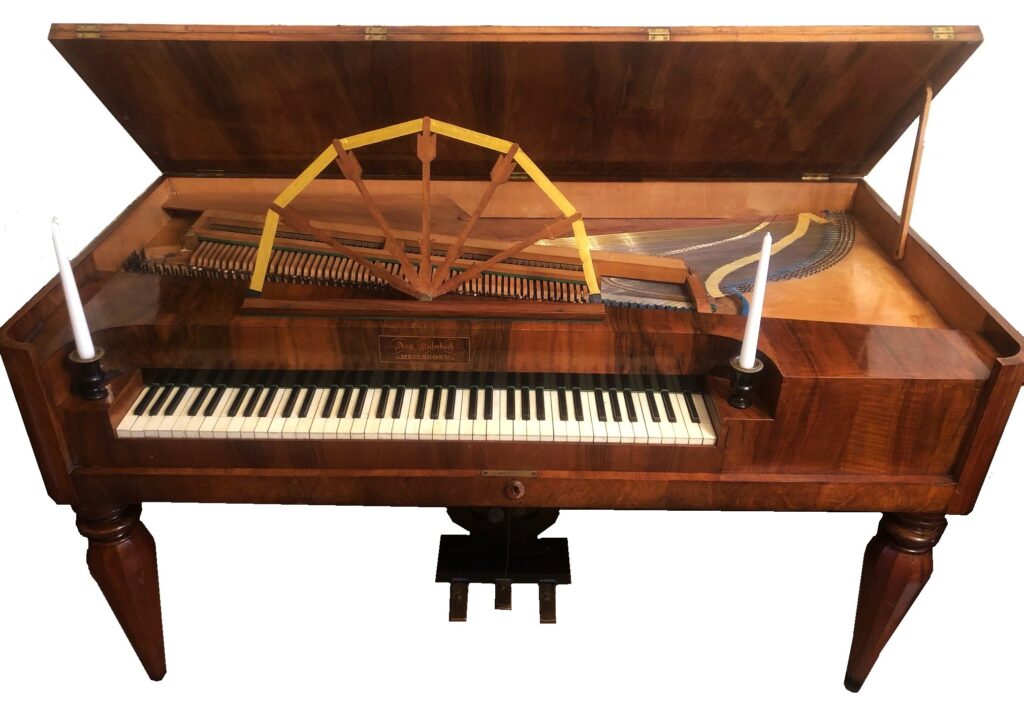
| Date: | 1828 - 1835 |
| Origin: | Heilbronn |
| Serialnumber: | 200 |
In the 19th century, the square piano experienced remarkable spread and development. This era was marked by significant changes in the art of musical instrument making as well as a growing interest in musical art and culture. The fortepiano, which emerged in the 18th century as the successor to the harpsichord, became increasingly popular in the 19th century. It was notable for its dynamic capabilities, allowing musicians to create nuances in volume. This was a significant advantage compared to its predecessors and contributed to the emergence of new musical styles. Technological advances in piano making made it possible to improve the quality of sound and introduce new special features (pedals, sound modifications, etc.).
The growing middle-class society of the 19th century also contributed to the popularity of the square piano. Music became an important part of middle-class life, and the piano found its place in many middle-class households.
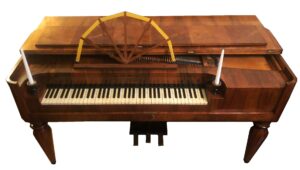
August Kulmbach, Heilbronn c. 1828 – 1830 – Eric Feller Collection (music stand)
The square piano presented here is a testimony to German piano making in the first half of the 19th century. The instrument was made between 1828 – 1835 in Heilbronn by the German piano maker August Kulmbach. The case and original legs are made of cherrywood and painted with shellac. The lyre is painted black and decorated with bronze applications. Two candle holders with bronze grommets are attached to each side of the keyboard. Behind the damper system is a dustcover that is fixed with a screw. The music stand can be opened and has a fan shape. The individual wooden elements of the fan are connected with a yellow ribbon. This type of music stand is typical for Kulmbach instruments.
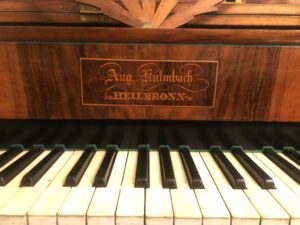
August Kulmbach, Heilbronn c. 1828 – 1830 – Eric Feller Collection (nameboard)
On the nameboard there is an inlaid cartouche with the inscription:
“Aug. Kulmbach
in Heilbronn A/N”
The square piano has a range of 6 octaves plus 2 keys (FF – g4) and has a Viennese action with leather-covered hammers. The keys are covered with bone plates. The instrument also has 3 pedals (dampers, moderato, bassoon). It has been restored twice in its past, as shown by a paper note stuck inside the instrument (1980, 1990). The serial number 200 is handwritten on the bottom of the case, under the action. The instrument is in playable condition and impresses with its great sonority and light touch of the keyboard, which makes it a perfect instrument of the classical and early romantic eras.
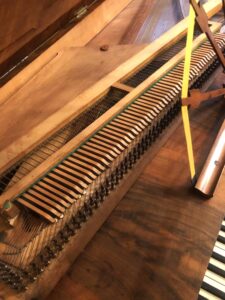
August Kulmbach, Heilbronn c. 1828 – 1830 – Eric Feller Collection (dampers and dust cover)
The square piano was provided in December 2023 by the city of Hilchenbach, which I would like to thank at this point!
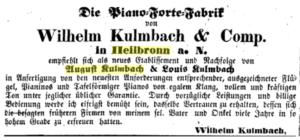
Wilhelm Kulmbach Advert – Regensburger Tageblatt No. 20, 1859
(Friedrich) August Kulmbach was born in 1803 and comes from a family of instrument makers that was founded in 1818 by his brother (Martin Friedrich) Ludwig Kulmbach (1790 – 1855). Ludwig Kulmbach lived at Schelengasse 256 and had his workshop behind the Nicolaikirche. His brother August Kulmbach worked with him from the first years of the company’s existence. Around 1826/27 August Kulmbach became self-employed and made his own instruments. Towards the middle of the century, Ludwig’s son Wilhelm Kulmbach (1833 – 1879) took over management of his brother’s Kulmbach factory. It is not yet known how long August Kulmbach made instruments. He died in 1856.
Other surviving instruments by August Kulmbach:
- c. 1835 square piano – Gemeentemuseum, The Hague, Netherlands
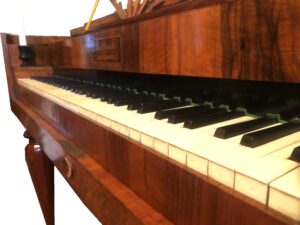
August Kulmbach, Heilbronn c. 1828 – 1830 – Eric Feller Collection (Keyboard)
| Length: | 165 cm |
| Width: | 78 cm |
| Height: | 33 cm |
| Circumference: | 6 octaves plus 2 keys (FF - g4) |
| Mechanics: | Viennese action |
| Pedals: | 3 pedals (dampers, moderato, bassoon) |
| Signature: |
"Aug. Kulmbach in Heilbronn A/N“ |

